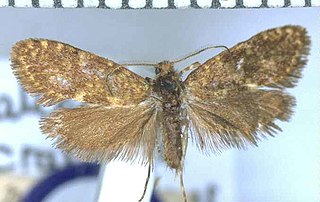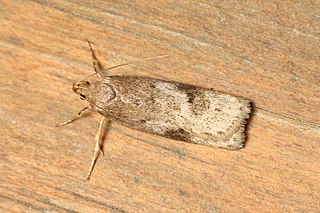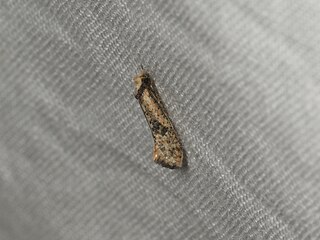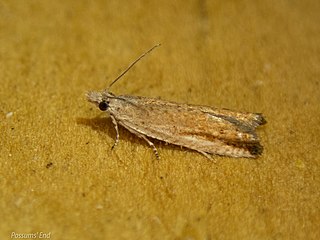
Hendecasticha is a genus of moths belonging to the subfamily Olethreutinae of the family Tortricidae. This genus was described by Edward Meyrick in 1881. It consists of only one species, Hendecasticha aethaliana, which is endemic to New Zealand.

Parienia is a genus of moths belonging to the subfamily Olethreutinae of the family Tortricidae. This genus was described by Edward Meyrick in 1881. It consists of only one species, Parienia mochlophorana, which is endemic to New Zealand.

Sabatinca chalcophanes is a moth of the family Micropterigidae. This species is endemic to New Zealand and is found in the North Island apart from Northland and in the South Island apart from in the east, south of Queen Charlotte Sound. The adults of this species are on the wing from November to April and as a result of this long period it has been hypothesised that this species has two broods. The preferred habitat of this species is in damp lowland forest. The larval host species are foliose liverwort species including Hymenophyton flabellatum.

Sabatinca chrysargyra is a species of moth belonging to the family Micropterigidae. It was described by Edward Meyrick in 1886 and is endemic to New Zealand. It can can be found from Franz Josef Glacier / Kā Roimata o Hine Hukatere south but only on the western side of the South Island. Adults are on the wing from the beginning of October until the middle of January. Larvae likely feed on foliose liverworts and have been found on species in the genus Plagiochila. The adult moths live in a range of habitats preferring sunny open spaces in forests or snow-tussock grasslands that can range in altitude from near sea level up to 1,230 m. This species is very similar in appearance to Sabatinca aemula and dissection of genitalia is required to distinguish between the two species.

Pyroderces aellotricha, also known as the Cosmet moth, is a moth of the family Cosmopterigidae. It is found in New Zealand, in Australia and the Cook Islands.

Gymnobathra callixyla is a moth in the family Oecophoridae first described by Edward Meyrick in 1888. It is endemic to New Zealand.

Anisoplaca acrodactyla is a species of moth of the family Gelechiidae. It was described by Edward Meyrick in 1907 and is endemic to New Zealand. This species has been observed in South Island as well as in the North Island. Larvae feed on species in the genera Hoheria and Plagianthus including the species Plagianthus regius'.

Aristotelia paradesma is a moth of the family Gelechiidae. It was described by Edward Meyrick in 1885 and is endemic to New Zealand. This species has been observed on both the North and South Islands. The larvae feed on Coprosma species creating and living in stem galls. The adults are on the wing from November to March and are attracted to light.

Mallobathra is a genus of moths belonging to the family Psychidae, and are bagworm moths. This genus was first described by Edward Meyrick. It is endemic to New Zealand. The type species of this genus is Mallobathra crataea.

Atomotricha oeconoma is a moth in the family Oecophoridae first described by Edward Meyrick in 1914. It is endemic to New Zealand.
Leptocroca antinoma is a moth of the family Oecophoridae first described by Edward Meyrick in 1910. It is found in New Zealand at the Kermadec Islands and has also been collected in Australia.

Phaeosaces apocrypta is a species of moth in the family Depressariidae. It was first described by Edward Meyrick in 1885. This species is endemic to New Zealand.

Scythris epistrota is a species of moth in the family Scythrididae first described by Edward Meyrick in 1889. It is endemic to New Zealand.

Scythris triatma is a species of moth in the family Scythrididae first described by Edward Meyrick in 1935. It is endemic to New Zealand.

Amphixystis hapsimacha is a species of moth in the family Tineidae first described by Edward Meyrick in 1901. It is endemic to New Zealand.

Amphixystis paraglypta is a species of moth in the family Tineidae first described by Edward Meyrick in 1889. It is endemic to New Zealand.

Strepsicrates sideritis is a species of moth in the family Tortricidae first described by Edward Meyrick in 1905. This species is endemic to New Zealand. The classification of this moth within the genus Strepsicrates is regarded as unsatisfactory and in need of revision. As such this species is currently also known as Strepsicrates (s.l.) sideritis.

Monopis argillacea is a moth of the family Tineidae first described by Edward Meyrick in 1893. It is found in Australia and New Zealand.

Holocola zopherana is a species of moth in the family Tortricidae first described by Edward Meyrick in 1881. This species was previously placed in the genus Strepsicrates. It is found in Australia and New Zealand.

Prothelymna potamias is a species of moth in the family Tineidae first described by Edward Meyrick in 1909. This species is endemic to New Zealand.



















